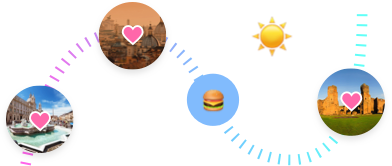



Hong Kong Disneyland (Chinese: 香港迪士尼樂園) is a theme park located on reclaimed land in Penny's Bay, Lantau Island. It is located inside the Hong Kong Disneyland Resort and it is owned and managed by Hong Kong International Theme Parks. It is, together with Ocean Park Hong Kong, one of the two large theme parks in Hong Kong. Hong Kong Disneyland opened to visitors on Monday, 12 September 2005 at 13:00 HKT. Disney attempted to avoid problems of cultural backlash by incorporating Chinese culture, customs, and traditions when designing and building the resort, including adherence to the rules of feng shui. For instance, a bend was put in a walkway near the Hong Kong Disneyland Resort entrance so good qi energy wouldn't flow into the South China Sea. The park consists of seven themed areas: Main Street, U.S.A., Fantasyland, Adventureland, Tomorrowland, Grizzly Gulch, Mystic Point, and Toy Story Land. The theme park's cast members speak Cantonese, English, and Mandarin. Guide maps are printed in traditional and simplified Chinese as well as English.
The Ngong Ping 360 is a gondola lift on Lantau Island in Hong Kong. Intended to improve tourism to the area, the aerial lift was previously known as Tung Chung Cable Car Project before acquiring the Ngong Ping 360 brand in April 2005. It consists of the Ngong Ping Cable Car, formerly known as the Ngong Ping 360 Skyrail, and the Ngong Ping Village, a retail and entertainment center adjacent to the cable car's upper station. Ngong Ping 360 connects Tung Chung, on the north coast of Lantau and itself linked to central Hong Kong by the Tung Chung Line, with the Ngong Ping area in the hills above. This is home to the Po Lin Monastery and the Tian Tan Buddha, both already significant tourist attractions in their own right. Before Ngong Ping 360's opening, the only access was via a mountain road and bus service. Ngong Ping 360 is owned by the MTR Corporation, the operator of Hong Kong's rail system. It was built by Leitner Ropeways and was originally operated by Skyrail-ITM. Skyrail-ITM was removed from the project after an investigation following an incident in June 2007. It is now operated by a directly owned subsidiary of the MTR Corporation.
The Ten Thousand Buddhas Monastery (Chinese: 萬佛寺; pinyin: wàn fó sì) is a mid-20th century Buddhist temple located in Sha Tin, Hong Kong, at 220 Pai Tau Village. Its designation as a monastery is actually a misnomer because there are no monks residing at the complex, which is managed solely by laypersons. Both the main temple building and the pagoda are listed as Grade III historic buildings by the Government of Hong Kong. Groundbreaking and construction of the temple began in 1951 under Yuet Kai and his followers, and the structure was finished six years later. It closed for three years at the end of the 20th century after one of its caretakers was killed in a mudslide caused by poorly-maintained slopes nearby. The main journey up to the monastery is an attraction itself, as the path is lined on both sides with golden Buddhas, each unique and in different poses. Despite the common translation of its name, the monastery actually contains nearly 13,000 Buddha statues.
Kowloon Walled City was a largely ungoverned, densely populated settlement in Kowloon City in Hong Kong. Originally a Chinese military fort, the Walled City became an enclave after the New Territories were leased to Britain by China in 1898. Its population increased dramatically following the Japanese occupation of Hong Kong during World War II. By 1990, the Walled City contained 50,000 residents[1] within its 2.6-hectare (6.4-acre) borders. From the 1950s to the 1970s, it was controlled by local triads and had high rates of prostitution, gambling and drug abuse.
Quarry Bay is a densely packed neighborhood in Eastern Hong Kong, with more and more industrial and residential spaces opening each year, but perhaps no building is quite as condensed as this hulking behemoth: actually five interconnected towers built in the 1960s, its individual units are stacked one on top of the other and create a colorful, cohesive tapestry of homes. The Monster Building, as it’s been nicknamed by locals, was built during a population boom in the 1960s to offer government-subsidized housing for low-income residents. Because of its photo-friendly symmetry and aesthetically striking architecture, the building has become a favorite spot for urban explorers and Instagrammers. The area has been used as a set in multiple films.